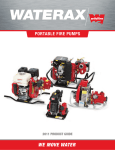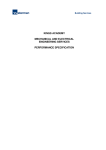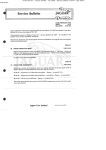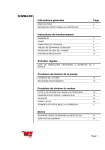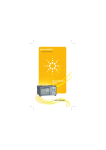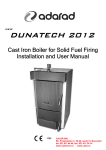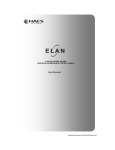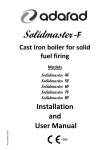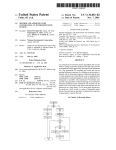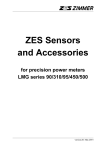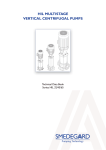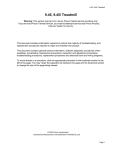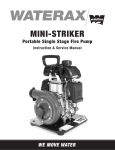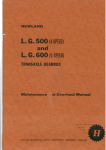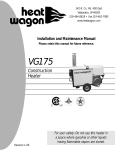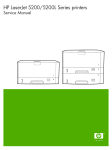Download TABLE OF CONTENTS - Découvrez Protect Forest
Transcript
TABLE OF CONTENTS
1
5
GENERAL INFORMATION
MAJOR OVERHAUL SERVICE
SPECIFICATIONS
2
ENGINE OVERHAUL SERVICE PROCEDURE
31
SERIAL NUMBERS
3
DISASSEMBLY PROCEDURE FOR ENGINE
32
REASSEMBLY SERVICE FOR ENGINE
33
DISASSEMBLY PROCEDURE FOR PUMP END
34
ASSEMBLY PROCEDURE FOR PUMP END
35
2
ENGINE OPERATING
STARTER
4
OPERATING INSTRUCTIONS
4
FLOODING
6
COLD WEATHER
6
TROUBLESHOOTING CHART
7
ELECTRONIC IGNITION
8
3
9
PUMP TEST KIT
10
PUMP ADJUSTMENTS
11
UPGRADED CUT-OUT SWITCH
12
4
MISCELLANEOUS
OPTIONAL NOISE REDUCTION MUFFLER
38
DECARBONISING
38
7
PUMP UNIT
PUMP OPERATION AND LUBRICATION
6
TECHNICAL SPECIFICATIONS
TORQUE VALUES
39
CLEARANCE DATA AND LIMITS
39
8
PARTS INDEX
40
9
WARRANTY CERTIFICATE
44
REGULAR MAINTENANCE
MAINTENANCE CHECK LIST
13
UPGRADED SPARK PLUG CAP
14
SERVICING SPARK PLUG
14
ELECTRONIC IGNITION UNIT
15
ELECTRONIC IGNITION MODULE SETTINGS
16
DECOMPRESSION SWITCH R-233DS
17
SERVICING CARBURETOR
18
CARBURETOR TROUBLE CHART
21
SERVICING AIR FILTER
22
SERVICING COOLING SYSTEM
23
SERVICING THE REWIND STARTER
24
SERVICING MAGNETO
29
w w w. w i l d f i r e - e q u i p m e n t . c o m
1
The MARK-3 unit has been designed
to meet all the requirements of
advanced techniques in forest fire
control, including USDA Forest
Service Specifications No. 5100274C. This versatile unit enables the
pump to be used for high pressure
and volume (B-2 volume Pump End
interchangeability). It is also suitable
for rural and municipal fire protection, or wherever a large volume of
water or high pressure is required.
Tandem operations enable to move
water over greater distances or
higher altitudes.
400
2758
300
1379
689
200
The MARK-3 Engine is a one-cylinder, two-cycle, air-cooled engine incorporating
ball and roller bearings. The unit is also equipped with a rewind pull-cord starter
and automatic cutout switch.
100
The MARK-3 Pump end is an anodized horizontal 4-stage centrifugal precision
built pump. Both the 2” (51 mm) NPSH male suction connection and 1 1/2”
(38mm) NPSH male discharge connection are made to standard forestry thread
specifications.
kPa
This handbook includes specifications, performance data, operating
instructions, normal servicing information and parts list for the MARK-3
centrifugal fire pump unit.
SPECIFICATIONS
2068
GENERAL INFORMATION
psi
1
1
GENERAL INFORMATION
MK-3
Maximum Pressure : 380 psi (2620 kPa)
Free flow : 98 US gals/min (370 L /min)
MK-3
MK-3-B2
Maximum Pressure : 155 psi (1068 kPa)
Free flow : 180 US gals/min (681 L /min)
MK-3-B2
US gals/min
50
100
150
200
L /min
189
379
568
758
WARNING
•
The improper use of this pump could result in serious injuries.
Please read the manual before using your MARK-3 pump unit.
•
Always wear eye and ear protection when operating the pump unit.
•
Be careful, never touch the muffler, as it can reach very high temperatures and
cause serious burns. Always allow enough time after stopping the unit for the
muffler and surrounding parts to cool down.
SERIAL NUMBERS
Always use proper fuel mixture to ensure suitable lubrication.
Pump end serial number is located on the side of the pump (1.1).
•
24:1
Engine end serial number is stamped on a nameplate attached to the crankcase
(1.2).
CHARACTERISTICS
Complete unit
58 lbs
26.3 kg
16 1/4”
413 mm
psi
kPa
bar
W idth
12”
305 mm
0
0
Length
23”
584 mm
50
15 lbs
6,8 kg
75
7,4 kW
100
C a r b u r e t o r Tillotson all position diaphragm
type with integral fuel pump and filter
150
200
Height
Pump end only
These serial numbers are the key to various design details pertaining to the original manufacture of each unit. Therefore, it is very important to specify serial
numbers whenever ordering parts and tools or when requesting information.
MAXIMUM PERFORMANCE
M a x . e n g i n e p o w e r 10 HP
Approx.
I g n i t i o n Ducati electronic
S p a r k p l u g Borsh M4, AC 18 mm or
Champion K7 18 mm
Consumption approx.
(1 IMP gal, 1.2 US gals) 5 L/hr
Pressure
Discharge Flow
US GPM
IMP GPM
L/min
0
98
82
371
345
3,45
89
74
337
517
5,17
83
69
314
690
6,90
78
65
295
1034
10,34
65
54
246
1379
13,79
52
43
197
250
1724
17,24
38
32
144
300
2069
20,69
25
21
95
350
2413
24,13
9
7
34
380
2620
26,20
0
0
0
1.1
All references to right side and left side of unit are made as they appear to operator when facing rewind starter, thus the carburetor is on the right side and the
muffler is on the left side.
Viewed in this manner (facing the recoil starter), the engine will rotate in a clockwise direction (1.3).
1.2
2
Wi l d f i r e
DIRECTIONAL REFERENCES
1.3
w w w. w i l d f i r e - e q u i p m e n t . c o m
3
2
2
ENGINE OPERATING
ENGINE OPERATING
TO START MARK-3 UNIT
1 Fill fuel supply tank with recommended fuel mixture.
2 Connect fuel supply line to fuel supply tank (1.5).
FOR TROUBLE FREE OPERATION
TIP
If the rewind starter should break
while the unit is on the fire line, the
complete rewind starter assembly
can be easily removed, thereby
gaining access to a manual starter
pulley which is mounted on the flywheel. Using a rope, wrap around
starter pulley and pull. Make sure
rope wrapping will ensure clockwise
rotation (from starter view).
•
•
•
•
•
DO NOT run engine at full speed until thoroughly warmed up.
•
•
DO NOT use suction hose without foot valve strainer.
3 Attach fuel supply line to the adaptor located on right side of engine frame.
Pump fuel to fill supply line (1.6).
DO NOT lift strainer out of the water while pump is operating.
DO NOT use suction hose without foot valve strainer. DO NOT allow foot
valve strainer to rest on bottom of lake or river bed.
DO NOT run engine with pump disconnected.
DO NOT run pump when dry. Priming?
Check strainer frequently to make sure that it is not clogged with moss,
leaves, etc.
4 Connect foot valve strainer to male end of suction hose, then fill suction
hose with water and connect to pump. 1 Use universal hose coupling
wrench to tighten coupling firmly (1.8).
1.5
5 Connect discharge hose 2 , nozzles, etc., to pump. Use a rope or other means
to keep strainer at proper height, approximately 30cm (1 foot) below water
surface. If strainer is too close to the water surface, it will draw air and pump
may lose prime (1.7).
Remove and drain pump after final use.
6 Fill pump with water manually or using a hand primer (B-5980), then replace
priming cap and tighten firmly (1.8).
STARTER
The starter is an automatic rewind type. A proper operating technique will add
many hours of life to the starter rope and starter.
7 Move throttle lever to "Start" and "Warm up" position. Verify that On/Off
switch is on "On" position (approx. 3 increments). Verify that the reset cutout
switch is not engaged (must be pushed in).
Grasp handle firmly and pull slowly until resistance (past compression), then
continue to pull with a short, vigorous stroke. Pulling handle sideways causes
excessive wear. If kickback occurs, let go of handle immediately.
When engine starts, retain grip on handle and allow rope to rewind slowly.
Note: The rope should be replaced when wear is apparent.
8 Close choke, if engine is cold.
9 Slowly turn engine until resistance (past compression).
1.6
10 Give starter rope several quick, steady pulls until engine "coughs".
11 Open choke slightly and pull starter rope until engine runs.
See rewind starter Servicing and Parts, page 24.
12 Slowly open choke and allow engine to warm up for at least 2 minutes before
using full throttle.
OPERATING INSTRUCTIONS
CAUTION
Not enough emphasis can be placed
on the use of correct gasoline and
oil mixture. Using less than the
recommended portion of oil will
cause overheating and possible
engine damage. Using more than
the recomme nded proportion of oil
will cause spark plug fouling, erratic
carburetion, excessive exhaust
smoke and rapid carbon deposits.
The MARK-3 engine was initially run-in at the factory. Full throttle operation can
be used provided the engine is given a thorough warm-up period beforehand.
OIL: High quality 2-cycle mixing oil.
FUEL: 87 Octane or higher automotive gasoline.
DO NOT use premium grade gasoline.
Important: Failure to allow the engine to warm up may lead to piston scoring
and possibly more serious damage.
Do not use poor quality oil, high detergent oil or oil with solid additives (graphite,
moly, T.F.E., etc.).
AUTOMATIC CUTOUT SWITCH
The MARK-3 unit is equipped with an automatic cutout switch. This safety device
will stop the engine instantly and thereby eliminate overspeeding.
MIXTURE RATIO
1.7
Oil
Gasoline
1 L (0.22 IMP gals, 0.26 US gals)
24 L (5.3 IMP gals, 6.3 US gals)
1 US Quart (0.95 L)
6 US gals (5 IMP gals, 22,75 L)
The switch works on cooling fan air pressure. As the engine speed increases, so
does the air pressure. At a predetermined speed, there is sufficient air pressure to
cause the air vane to move against its contacts, shorting the ignition and thereby
stopping the engine.
When the cutout switch automatically stops the engine, this is a warning
that there is a problem. Do not reset switch until cause of trouble has been
identified and corrected.
CONTROLS
1
There are only 4 controls which are used for normal operation: (1.4)
B-5980
1 ON/OFF switch
2
1.4
4
Wi l d f i r e
2 Throttle lever
4
3 Choke lever
3
4 Reset lever
TO STOP MARK-3 UNIT:
1 Move throttle lever to "Stop" position.
24:1
1
2
1.8
2 Allow unit to run for approximately 1 minute with throttle in this position.
3 Switch toggle to "Off" position.
4 Remove and drain pump after final use.
w w w. w i l d f i r e - e q u i p m e n t . c o m
5
2
2
ENGINE OPERATING
ENGINE OPERATING
FLOODING
TROUBLESHOOTING CHART
Flooding refers to an accumulation of excess fuel in cylinder, mainly due to excessive use of choke.
ENGINE DOES NOT START OR STARTS
MOMENTARILY THEN STOPS
ENGINE DOES NOT IDLE PROPERLY
When the engine is in a flooded condition, an over-rich fuel-air mixture is induced
into the cylinder. This mixture does not ignite readily and usually fouls the spark
plug.
Possible cause
Remedy
Possible cause
Remedy
Fuel supply tank empty
Refill fuel tank
Carburetor mountings loose
Tighten mountings
Fuel supply valve closed
Open supply valve
Too much oil in fuel mixture
See "Engine Lubrication and Fuel"
Air vent on fuel tank closed
Open air vent or unscrew cap
Idle mixture screw misadjusted
See "Service Manual"
Defective fuel supply hose
Replace
Spark plug fouled or defective
Clean or replace
Dirty fuel strainer screen
Clean or replace
Wrong type spark plug
Use plug recommended
Leak in fuel supply system
Tighten or replace fittings
See "Service Manual"
Refer to timing section
CLEANING A FLOODED ENGINE
Remove fuel supply line from engine or close fuel supply valve (if equipped).
Remove spark plug. With both choke and throttle in fully open position, pull starter
rope several times until excess fuel is exhausted. Before reinstalling spark plug,
clean and dry electrode and insulator tip.
COLD OPERATION
COLD WEATHER
In cold operation it is good practice
to put a small quantity of aluminum compatible antifreeze into
pump end through priming cap
immediately after use to prevent
damage from freezing.
RECOMMENDED PROCEDURE FOR COLD WEATHER OR
PROLONGED STORAGE
The following procedure is recommended to ensure proper protection of the
engine if the engine is to be left idle for prolonged periods between uses or if
there is a possibility that the engine may be stored in an unheated area where
freezing temperatures may occur.
1 With pump unit running at approximately low RPM (approx. 3-4 increment)
V2 throttle, remove the quick-connect fuel line from the quick-connect fitting
on the engine.
2 Allow engine to run until all fuel has left the carburetor and the engine stops.
3 Remove spark plug.
4 Rotate crankshaft until piston is at top dead centre.
Carburetor mountings loose
Tighten mountings
Main adjustment screw
misadjusted
Water or dirt in fuel system
Drain; flush thoroughly
Improper timing
Engine flooded
See "Flooding"
Too much oil in fuel mixture
See "Engine Lubrication and Fuel"
Spark plug fouled or defective
Clean or replace
No spark
See "Service Manual"
ENGINE RUNS IRREGULARLY OR MISSES
Possible cause
Remedy
Defective fuel supply hose
Replace
Dirty fuel strainer screen
Clean and replace
Leak in fuel supply system
Tighten or replace fittings
Carburetor mountings loose
Tighten mountings
Water or dirt in fuel system
Drain; flush thoroughly
Wrong gasoline in fuel mixture
See "Engine Lubrication and Fuel"
Too much oil in fuel mixture
See "Engine Lubrication and Fuel"
5 Pour 30 ml (1 oz) of oil into spark plug opening (use same oil grade used in
fuel mixture).
Air filter dirty
Clean or replace
Idle mixture screw misadjusted
See "Service Manual"
6 Rotate crankshaft 2 or 3 times to assure that cylinder walls are well coated
with oil, then bring piston to top dead centre.
Spark plug fouled or defective
Clean or replace
Wrong type spark plug
Use plug recommended
7 Reinstall spark plug.
Improper timing
Refer to timing section
It is preferable to keep the pump unit in dry storage above freezing temperature.
However, as this is not always possible, some slight rusting may occur, which
should have no detrimental effect on the life or performance of the unit.
ENGINE BACKFIRES
ENGINE DOES NOT DEVELOP NORMAL
POWER AND/OR OVERHEATS
Possible cause
Remedy
Carburetor mountings loose
Tighten mountings
Wrong gasoline in fuel mixture
See "Engine Lubrication and Fuel"
Wrong oil in fuel mixture
See "Engine Lubrication and Fuel"
Not enough oil in fuel mixture
See "Engine Lubrication and Fuel"
Too much oil in fuel mixture
See "Engine Lubrication and Fuel"
Air filter dirty
Replace
Spark plug fouled or defective
Clean or replace
Wrong type spark plug
Use plug recommended
Cooling system dirty
See "Service Manual"
Muffler blocked or dirty
Replace
Main adjustment screw
misadjusted
See "Service Manual"
Improper timing
Refer to timing section
ENGINE SOUNDS LIKE A FOUR STROKE
Possible cause
Remedy
Too much oil in fuel mixture
See "Engine Lubrication and Fuel"
Remedy
Engine not warmed up properly
Allow longer warm up period
Spark plug fouled or defective
Clean or replace
See "Service Manual"
Defective carburetor
Replace
Main adjustment screw
misadjusted
Improper timing
Refer to timing section
Air filter dirty
Clean or replace
Improper timing
Refer to timing section
Possible cause
Refer also to section on "Servicing Carburetor" in Service
Manual for additional "Trouble Data" and service information.
6
Wi l d f i r e
w w w. w i l d f i r e - e q u i p m e n t . c o m
7
2
3
ENGINE OPERATING
ELECTRONIC IGNITION
Since the introduction of the MARK-3 fire pump into the industry, the MARK-3
utilized breaker points in its ignition system, which inherently required maintenance; i.e. the gap adjustment, points cleaned and/or completely changed.
A more efficient and maintenance free
electronic ignition system.
Wi l d f i r e
Qty
_
212-170P Clamp assembly
(includes all the parts
listed below)
1
1
A-4460
Lever, zinc plated
1
2
A-4452
Side link for lever
1
The electronic ignition module is equipped with spark advance, thus allowing for a
cleaner burn at a higher RPM. During testing it was found that the engine ran
smoother and was much more responsive. When the engine is started cold, it runs
rough (as if the timing were off) for about 15-30 seconds, after which the engine
runs smooth.
3
C-4462-5 Cotter pin
4
A-4455
Clevis pin for lever side 2
5
B-4461
Clamp - top half
1
6
B-4457
Clamp- bottom half
1
7
A-4454
Clevis pin for
eye-bolt side
1
8
A-4456
Knob for tension
adjustment
1
Eye-bolt
1
The ignition cable is larger in diameter than the previous one used on the MARK-3
with breaker points.
8
Description
The upgrade to the electronic ignition system will eliminate the need for regular
maintenance associated with breaker points. The electronic ignition system uses a
magnetic pickup located on the flywheel, which when passing over a certain point
on the stator will induce a high voltage, therefore causing the spark plug to fire at
the proper moment.
In order to convert a MARK-3 from breaker points to the upgraded electronic
ignition system, the following retrofit kit was created: B-7595 MARK-3 Conversion
kit, point to CDI.
The electronic ignition allows for a
smoother and more responsive engine run.
Ref. Part #
9
A-4453
PUMP UNIT
PUMP OPERATING AND LUBRICATION
1
2
3
3
4
5
6
The breakdown of the electronic ignition is depicted in the picture to the left. The
electronic module is placed in an aluminium box located on the frame below the
carburetor shroud.
3
Ref. #
Description
7
-
B-7595
Mark-3 conv. Kit point to CD (Includes all parts with *)
-
A-7589
Mounting block/elect. Ignition (not shown)
Quantity
1
1
R-271
Electronic ignition *
1
2
R-275
Protection cap *
1
3
R-274
Ignition cable *
1
4
R-650
Spark plug connector *
1
5
R-629
Spark plug
1
8
9
w w w. w i l d f i r e - e q u i p m e n t . c o m
9
3
3
PUMP UNIT
PUMP LUBRICATION
Ref.
#
_
The pump bearing must be greased every 8 hours of operation.
Part
#
Description
A-2388
Pump test kit (incl. al the parts listed below)
PUMP UNIT
Qty
Use a clean grease gun filled with fresh grease. Remove dirt from grease fitting
before applying grease gun. Grease should be pumped slowly into grease zerk
while rotating the pump shaft. Continue pumping until fresh grease appears
around bearing ring. Wipe off excess grease.
1
A-2392
Pressure gauge 0-400 psi (0-2800 kPa), 4 1/2" (114 mm)
1
2
F5095E
Hose SPEC 187-1 1/2" X 10' w/brass coupling NPSH M/F F5095E00F10RBALFS
1
3
A-2389
Pump test kit box
1
4
A-2391
Rubber hose assembly (incl. a set of 2 adaptors A-2391B)
1
Do not use graphite grease or a pressurized grease gun.
5
A-2391B
Adaptor Female NPT-Swivel Female
2
6
A-2390A
Shut-off valve
1
TO REMOVE PUMP FROM ENGINE:
7
A-2390
Pressure gauge adaptor 1 1/2" (38mm) female NPSH to 1 1/2" (38mm) male NPSH
1
1 Lift pump clamp lever.
8
A-2395
Brass calibrated nozzle tip set: 1/8", 1/4", 5/16", 3/8", 7/16" (3mm, 6mm, 8mm, 9,5mm, 11mm)
1
2 Release tension adjusting knob at bottom of clamp.
9
C-1933
Calibrated nozzle, 1/2" (12,7mm)
1
3 Remove clamp.
4 Remove pump from engine.
COLD OPERATION
In cold operation it is good practice
to put a small quantity of aluminum compatible antifreeze into
pump end through priming cap
immediately after use to prevent
damage from freezing.
TO DRAIN PUMP:
It is recommended that the pump be drained after usage. This is a MUST during
cold weather, to prevent damage to pump, due to freezing.
1 Remove discharge hose, suction hose and priming cap.
2 Drain pump by tilting pump body several times.
3 Stand pump on suction nozzle end for several minutes to complete drainage.
4 Replace discharge, suction and priming caps.
TO ATTACH PUMP TO ENGINE:
IMPORTANT
Apply FINGER PRESSURE ONLY to
close pump clamp lever. Excessive
pressure will damage or break
clamp link.
1 Place flexible buffer coupling on engine coupling pins.
2 Align flexible buffer coupling holes to pump end coupling pins and install.
3 Attach pump clamp. Carefully align clamp positioning pins with flange stub.
4 Adjust tension knob located at bottom of clamp to obtain a light pressure on
clamp link.
PUMP ADJUSTMENTS
OVERSPEEDING MAY OCCUR IF:
PUMP TEST KIT
1 Pump not primed properly.
TESTING PROCEDURE
•
•
The best way to check your pump unit is to make an actual performance test. A
test kit consisting of pressure gauge, pressure gauge adaptor, 3 m (10') length of
discharge hose, a nozzle and a calibrated set of nozzle tips, is available.
Suction hose and/or pump body not completely filled with water.
A bend in the suction hose, located higher than the pump suction inlet,
causing an air lock. (The suction hose between the pump and water supply
must have a downward slope.)
2 Loose suction hose coupling or priming cap.
10
Nozzle
Size
1/2"
12,7 mm
7/16"
11 mm
3/8"
9,5 mm
5/16"
8 mm
1/4"
6 mm
1/8"
3 mm
Minimal
Pressure
105 psi
724 kPa
145 psi
1000 kPa
180 psi
1241 kPa
225 psi
1551 kPa
265 psi
1827 kPa
320 psi
2206 kPa
Minimal
Pressure Range
100-105 psi
689-724 kPa
125-130 psi
862-896 kPa
165-170 psi
1138-1172 kPa
210-215 psi
1448-1482 kPa
255-260 psi
1758-1793 kPa
315-320 psi,
2172-2206 kPa
Wi l d f i r e
IMPORTANT
Carburetor should be properly
adjusted before starting performance
test. See "Carburetor Adjustment".
In addition the pump unit should
be set up as close as possible to
water source.
3 Foot valve strainer clogged or too close to surface of water.
4 Pump loses prime.
•
Due to lack of water, air lock may form in the suction hose when pump
unit works against a high delivery head. If this happens, disconnect the
discharge hose from the pump then reprime pump in the normal manner.
•
Pump runs out of water, either because of lack of sufficient water supply or
by attempting to pump water from a shallow water source.
w w w. w i l d f i r e - e q u i p m e n t . c o m
11
3
4
PUMP UNIT
UPGRADED
CUT-OUT SWITCH
MARK-3 UPGRADE OF THE
B-6288 CUT-OUT SWITCH
(The change in material of the
air vane from Aluminium to
Stainless Steel)
The aluminium air vane used on
the B-6288 cut-out switch has been
in service for many years with no
complaints.
However, during harsh field testing,
it was discovered that the air vane
had deteriorated where the reset
rod connects into the air vane.
Intense vibrations would cause the
reset rod to vibrate with respect to
the air vane. This would in turn
cause a hammering effect that
would slowly enlargen the point of
attachment of the reset rod to the
air vane.
Therefore, it was decided to upgrade
the material of the air vane from
aluminium to stainless steel. This
would inherently allow the air vane
to last longer, thereby extending the
life of the cut-out switch.
The foot valve must remain at least 30 cm (1 foot) under the water surface while
pump is operating.
12
Wi l d f i r e
REGULAR MAINTENANCE
MAINTENANCE CHECK LIST
CUTOUT SWITCH ADJUSTMENT (STATIC)
Regular maintenance is a schedule of continuous systematic maintenance,
designed to prevent frequent or major breakdowns before they occur.
Maintenance on a fire pump unit should not be done on the fire line.
Always, check your pump unit immediately after use.
The cutout switch must be adjusted when installed in the fan cowl. This is necessary
because slight changes in the shape of the mounting plate occur when fastened in
position on the fan cowl.
1
2
3
4
5
6
7
8
9
10
11
12
13
Check that, with the air vane in the approximate centre of its travel, the spring
attachment holes "line up" with the pivot to form a straight line (see figure X).
All brackets and pivot should be perpendicular with the face of the plate.
Initial setting: A preliminary setting can be made by placing on the vane an
object sufficiently heavy to cause the vane to just leave the stop and start to
move towards the contacting position. A 2.5 oz (70 g) weight is used to approximate the setting during assembly. The final calibration must be made with the
engine running.
CUTOUT SWITCH ADJUSTMENT (DYNAMIC)
1 Setup pump unit close to water supply. Use a 2 m to 3 m (6' to 10') suction
hose with foot valve attached. Connect a short length 2 m to 3 m (6' to 10') of
discharge hose to pump outlet. Attach a calibrated nozzle having a 12,7 mm
(1/2") diameter orifice.
14
15
16
17
2 After starting and warming up engine thoroughly, increase to maximum recommended power, then lift foot valve out of water supply. Engine will speed up
then stop suddenly, indicating the automatic cutout switch is functioning.
Assuming that cutout is functioning, then the speed setting of the switch should be
checked to make sure that it is not set too low or too high.
Use a reliable tachometer to check engine RPM.
New reinforced Stainless Steel Air vane.
Stainless Steel for better durability.
PUMP UNIT
All suction couplings, including foot valve, must be wrench tightened. Proper fitting
gaskets must be used in all coupled joints. Worn or dried out gaskets should be
replaced with new gaskets.
Should the switch not cutout after 1-2 seconds, while engine is running at
increased speed, close throttle and toggle switch immediately, otherwise serious
engine damage may result.
Shown with deterioration.
Old style Alum. Air vane
3
3 Located in the upper centre of the outer surface of the fan housing, is a small
socket head adjustment screw. By using a 1/16" Allen key (tool R-909) and
turning this screw 1/2 turn clockwise will increase the cutout speed setting
approximately 150 RPM. A 1/2 turn counterclockwise will decrease speed
setting approximately 150 RPM. After each adjustment, recheck the actual
speed at which cutout switch operates until proper setting is obtained.
18
Ref. Part
##
_
R-900
Clean unit thoroughly.
Clean air filter.
Clean fan housing and air intake screen.
Make sure cooling passages and cylinder fins are clean.
Make sure spark plug is cleaned and has proper gap setting.
Check stop switch for proper operation.
Check throttle and choke control for proper operation.
Make sure carburetor fuel strainer screen is clean.
Check fuel line and fittings for signs of wear, etc.
Check and grease pump end (as per instructions in previous section)
Check starter cable and mechanisms and replace if it shows signs of wear.
Check condition of buffer coupling.
Operate pump unit and check general performance. Adjust carburetor if
necessary (see Service Manual for details)
Check carburetor adjustments.
Note any performance irregularities or any abnormal mechanical sounds.
Make sure pump seal is not leaking.
Make sure that all necessary tools, spares and accessories are with pump unit.
It is strongly suggested to always have an extra spark plug on hand.
Make sure electronic ignition module is free of debris. Verify condition of wiring
and connections.
Description
Maintenance tool kit (incl. all parts listed below)
Qty
1
1
Part-117 Grease gun
1
2
271-923 Wrench - adjustable 8" (203mm)
1
3
R-911M
Wrench - box & open end 1/2" (13mm)
1
4
R-906M
Wrench - box & open end 3/8" (10mm)
1
5
R-910
Wrench - open end 1/2"-9/16" (13-14mm)
1
If a reliable tachometer is not available, then the cutout switch may be roughly
calibrated as follows:
6
R-902
Screwdriver 2" (51mm)
1
7
R-904
Wrench - spark plug
1
Use a 3 mm (1/8") orifice tip screwed to nozzle. After warming up engine thoroughly,
increase to full throttle, then turn adjustment screw slowly counterclockwise until
switch cuts out and stops engine. Now turn screw one full turn clockwise and leave it
in this position.
8
A-3023
Carburetor adjusting tool
1
9
R-901
Screwdriver, 4" (102mm) sq. handle
1
10
R-903
Feeler gauge - spark plug & breaker point
1
11
R-908
Wrench - open end 5 & 8mm (ignition)
2
12
R-905
Handle - rod
1
13
271-488 Bag - tool roll (not shown)
1
14
271-928 6 mm T-handle Hex 10.5" LG
1
The cutout switch will now operate automatically to stop engine should pump run
out of water, lose prime, etc. The switch will not interfere with normal operation of
the unit and will also allow the use of small nozzle tips as well as complete pump
shut-off for short periods of time.
3
4
5
1
14
10
2
6
8
7
12
9
11
w w w. w i l d f i r e - e q u i p m e n t . c o m
13
4
4
REGULAR MAINTENANCE
SERVICING SPARK PLUG
Operating with a defective or incorrect spark plug will affect the engine's performance; hard starting, fouling, missing, overheating, pre ignition or lack of power. To
service and inspect the spark plug, perform the following steps as required:
ELECTRONIC IGNITION UNIT
2
1
2 Disconnect spark plug cable and remove spark plug.
3 Clean spark plug and inspect carefully. If tip of insulator core is rough,
cracked, broken or blistered, or if electrodes are burned away to the extent
that they are too thin and cannot be satisfactorily adjusted to recommended
gap. 0.016" -0.020" (0.41-0.51mm), replace with new plug.
Note: Use R-629 spark plug.
Use only spark plug type specified by engine manufacturer.
Refer also to section on "Servicing
Carburetor" for additional "Trouble
Data" and service information.
4 Reinstall spark plug. Start threads one or two turns with fingers to avoid danger
of cross threading. Tighten spark plug to recommended torque of 25 Nm
(18 ft-lbs or 215 inch-lbs).
(Short explanation for retrofit installation of an electronic ignition unit on the
MARK-3 engine which was originally fitted with contact breaker ignition)
PROCEDURE:
1 Remove spark plug cover.
IMPORTANT
REGULAR MAINTENANCE
5 Connect spark plug cable.
•
•
Remove old flywheel and armature plate.
•
Turn crankshaft until the piston is 3.75 mm before top dead centre, measuring
through the spark plug hole with a dial gauge. For the final dynamical ignition
timing check make an ink mark on the coupling buffer 12-17 3 as well as on
the flange – pump mounting R-136. 4
•
•
Fit electronic box. 5
•
If the 2 marks do not correspond, remove flywheel and loosen the 3 screws
2 of the armature plate, turn armature plate slightly in the direction needed.
Repeat the procedure until the marks correspond.
•
Seal rubber grommet 6 with Silastic.
6 Install spark plug cover; tighten screws securely.
Caution: Ceramic insulation of spark plug is easily damaged by shock stresses or
bending stresses as may be imposed by dropping, striking with hard objects or
overtightening. Therefore, if spark plug has been subjected to such accidental
abuse, it should be carefully inspected and tested before further use.
3
4
Fit the new armature plate approximately centrally of the long holes 1 , then
turn it approx. 1 mm anti-clockwise, then tighten the 3 screws. 2
Start engine and check ignition timing with a stroboscopic lamp. The 2 marks
3 4 previously made must correspond at 3000 – 4000 r.p.m.
UPGRADED
SPARK PLUG CAP
For years the MARK-3 has been using a rubber spark plug
connector R-650. The rubber connector has been known to
crack where the wire goes into the connector and where
the rubber connector goes onto the spark plug.
5
The rubber connector was replaced with a new robust
type of connector used on high performance recreational
vehicles. The new connector has the added benefit of
being able to shield against signals.
The part number will still remain the R-650.
A new robust type of connector will replace the old spark plug
rubber cap.
6
14
Wi l d f i r e
w w w. w i l d f i r e - e q u i p m e n t . c o m
15
4
4
REGULAR MAINTENANCE
ELECTRONIC IGNITION MODULE SETTINGS
Table
System
Part number
Resistance value Check
Ø116mm Flywheel magneto
492.19.6009
Resistance value Check
CDI unit with H.V. coil
432.39.9510
DECOMPRESSION SWITCH R-233DS
The MARK-3 model MK-3-DS features a decompression switch that significantly
facilitates starting the pump.
To convert existing Mark-3’s, simply replace the cylinder head with an R-233DS
(New cylinder head including a decompression switch assembly).
KEY CHARACTERISTICS
FLYWHEEL MAGNETO
+/-
Green wire
Green wire
Ground (stator)
-
225 ÷ 255 Ω
Ground (stator)
225 ÷ 255 Ω
-
CDI UNIT WITH INTEGRATED IGNITION COIL
+/testing pin
STOP
VERDE (G)
Ground
STOP
-
≤ 0.1 Ω
≥ 50 MΩ
≥ 50 MΩ
VERDE
(G)
≤ 0.1 Ω
-
≥ 50 MΩ
≥ 50 MΩ
Ground
(red wire)
≥ 50 MΩ
≥ 50 MΩ
-
H.V. output
(AT)
≥ 50 MΩ
≥ 50 MΩ
Decompression switch makes easy pulling / starting of recoil starter on high
compression MARK-3
•
•
•
•
Engine fires up much easier
No kick back
Easily engaged, simply push decompression switch in
Automatically disengages / closes when engine starts
PARTS BREAKDOWN
4.7 ÷ 5.5 KΩ
Testing Temperature: 25° C.
Values (in ohm) detected by Tester Digital BECKMAN RMS 3030.
INSTALLATION NOTES
The above said values are not always a guarantee of perfect efficiency of
the part.
•
•
4.7 ÷ 5.5 KΩ
-
Notes:
•
•
•
•
•
•
•
•
H.V. output.
REGULAR MAINTENANCE
Decompression Switch: A-7627
Copper Washer: A-7628
Cylinder Head: R-233 (machined head not sold separately)
Head Gasket: R-238 (not shown)
Torque value for decompression switch: 190-210 in-lbs (21-24 Nm).
Install cylinder head with decompression switch oriented towards pump end.
N O T E : Not yet available on MK-3-GSA version.
R-233DS
A-7627
A-7628
R-233
Exploded view R-233DS
16
Wi l d f i r e
w w w. w i l d f i r e - e q u i p m e n t . c o m
17
4
4
REGULAR MAINTENANCE
SERVICING CARBURETOR
CARBURETOR DESCRIPTION
18
Wi l d f i r e
Ref.#
_
Part#
R-1115
1
2
3
4
5
6
7
8
9
10
11
12
13
14
15
16
17
18
19
20
21
22
23
24
25
26
27
28
29
30
31
32
33
34
35
36
37
38
39
40
41
42
43
44
45
46
_
R-1045
R-1113
R-1041
R-1040
R-1026
R-1035
R-1039
R-1019
R-1020
R-1021
R-1022
R-1030
R-1020
R-1021
R-1022
R-1004
R-1036
R-1037
R-1038
R-1101
R-1111
R-1112
R-1110
R-1001
R-1034
R-1046N
R-1047
R-1003
R-1002
R-1005
R-1041
R-1024
R-1023
R-1029
R-1025N
R-1008
R-1009
R-1010
R-1011
R-1012
R-1013
R-1015
R-1016
R-1014
R-1017
R-1018
R-1050
Description
Carburetor (includes parts listed below
except R-1113)
Body
Gasket-carburetor
Mach. screw with lockwasher
Throttle shutter
Inlet control lever pinion screw
Throttle shaft and lever
Throttle shaft return spring
Idle mixture screw
Idle mixture screw spring
Flat washer, brass
Idle mixture screw packing
High speed mixture screw
High speed mixture screw spring
Flat washer, brass
High speed mixture screw packing
Choke shaft and lever
Throttle shaft clip
Lockwasher
Mach. screw
Throttle link lever assembly
Bolt
Flat washer
Hex nut
Body channel welch plug
Nozzle check valve
Inlet needle and seat
Inlet seat gasket
Choke friction spring
Choke friction pin
Choke shutter
Mach. screw with lockwasher
Idle speed screw spring
Idle speed screw
Inlet tension spring
Inlet control lever
Diaphragm gasket
Diaphragm
Diaphragm cover
Fuel pump gasket
Fuel pump diaphragm
Fuel pump body
Fuel strainer screen
Fuel strainer cover gasket
Mach. screw with lockwasher
Fuel strainer cover
Mach. screw
Repair parts kit (includes parts R-1001,
R-1008, R-1009, R-1113, R-1025N, R-1011,
R-1012, R-1016, R-1046N, R-1046N-L)
REGULAR MAINTENANCE
The carburetor can be cleaned with a minimum of tools.
Before disassembling carburetor it is imperative to flush it
clean of dirt by using proper carburetor cleaner.
1 Remove strainer cover retaining screw and plastic cover.
2 Remove strainer cover gasket and strainer screen.
3 Remove screws and fuel pump body.
4 Remove fuel pump diaphragm and gasket.
5 Remove main diaphragm cover plate.
6 Remove main diaphragm and main diaphragm gasket.
7 Remove inlet control lever fulcrum pin, lever and tension
spring.
8 Remove inlet needle.
9 With a thin wall 8 mm (5/16") hex socket carefully remove
the inlet seat. Remove inlet seat gasket. When reinstalling
seat, tighten only to 3 or 4 Nm (25-35 inch-lbs).
10 Remove idle and high speed mixture screws.
11 When reinstalling O-ring type adjusting screws, lubricate
with SAE-30 oil to prevent seizing. Packing spring type
adjustments do not require lubrication.
12 The ball check type main nozzle can be removed by tapping it out of the body casting into the venturi with a
small punch. A replacement ball check nozzle should be
pressed into the casting. The brass cage should be
pressed flush with the metering chamber casting.
Before reassembling the carburetor (in reverse order as outlined above) wash all component parts in carburetor cleaner
and blow off with compressed air. The channels in the
metering body should be cleaned by blowing through the
idle and main adjusting orifices. All fuel passages in the
three castings should be cleaned with compressed air.
Do not clean orifices or passages with wires or drills as this
might damage and cause incorrect operation of the carburetor.
When reassembling the inlet control lever and spring, make
sure that the spring rests in the well of the metering body
and locates on the dimple of the inlet control lever.
Do not stretch spring. Inlet control lever is properly set when
flush with floor of diaphragm chamber.
Be certain main diaphragm, gasket and cover casting are
carefully fitted over the three small pins cast in rim at bottom of metering body. Also the fuel pump gasket,
diaphragm and fuel pump body are placed over similar pins
at bottom rim of main diaphragm cover casting. Evenly
tighten fuel pump body retaining screws to insure complete
seal of casting separations at both diaphragms.
Frequent cleaning or replacement of the fuel strainer screen
will aid satisfactory operation of the carburetor.
w w w. w i l d f i r e - e q u i p m e n t . c o m
19
4
4
REGULAR MAINTENANCE
SERVICING CARBURETOR (CONTINUED)
CARBURETOR TROUBLE CHART
CARBURETOR ADJUSTMENT
CARBURETOR FLOODING
Possible cause
REGULAR MAINTENANCE
Remedy
The carburetor is provided with three adjustments, namely high speed (main)
adjustment; low speed (idle) adjustment; and idle speed regulating screw.
Dirt or foreign particles preventing inlet needle from seating.
Remove, clean and replace.
Diaphragm lever spring not seated on lever dimple.
Remove lever and reinstall.
1 Before starting pump unit, close both main and idle adjustment screws, by
turning clockwise, until needle just touches seat.
Diaphragm improperly installed in carburetor.
Replace diaphragm or correct installation.
Improper use of choke
Proper use of choke at start-up
Note: Turn adjustment screws carefully and gently. Do not force needle into seat,
otherwise, both needle and seat may be permanently damaged.
ENGINE WILL NOT ACCELERATE
2 Open main adjustment screw 1 turn, by turning counterclockwise.
Possible cause
Remedy
3 Open idle adjustment screw 1 turn, by turning counterclockwise.
Idle adjusting screw set too lean.
Enrich idle adjustment.
Incorrect setting on diaphragm lever.
Reset.
4 Turn idle speed regulating screw until throttle shutter is slightly open.
Diaphragm cover plate loose.
Tighten.
5 Start unit. Open choke slowly, and allow engine to warm up thoroughly, gradually increasing speed to full throttle setting while running with 6 mm (1/4")
diameter nozzle tip connected to a 3 m (10') discharge hose.
Diaphragm gasket leaking.
Replace.
Main fuel orifice plugged.
Remove diaphragm cover, diaphragm, diaphragm lever and main
adjusting screw. Clean out orifice by blowing through main adjustment
threaded hole.
6 When engine is thoroughly warmed up, close throttle, then adjust idle adjustment screw and idle speed regulating screw, until engine idles smoothly
between 2000-2200 RPM.
7 Increase speed gradually to full throttle setting, then turn main adjustment
screw until engine gives maximum RPM and pump delivers maximum pressure. Then, turn main adjustment screw 1/4 turn maximum counterclockwise.
This setting will give correct mixture ratio to assure proper engine lubrication.
Do not leave main adjustment screw set too lean, otherwise serious engine damage may occur due to lack of sufficient lubrication.
Note: It will be necessary to readjust the carburator when taking the pump from
one altitude and placing in a different altitude. Repeat step 1 to 7.
ENGINE WILL NOT IDLE
Possible cause
Remedy
Incorrect idle adjustment.
Reset to best idle.
Idle discharge ports or channels clogged.
Blow out with compressed air, or if compressed air is not available,
clean and flush with gasoline.
Diaphragm lever set incorrectly.
Reset diaphragm lever so it is flush with the floor of the diaphragm
chamber.
Throttle shutter cocked in the throttle bore causing fast idle.
Reset.
Dirty nozzle check valve.
Clean and/or replace.
Welch plug covering the idle discharge ports does not seal.
This causes the engine to idle with idle adjustment shut off.
Replace welch plug, following instructions outlined in service manual.
ENGINE RUNS OUT LEAN
Possible cause
Remedy
Tank vent not working properly.
Clean and/or replace.
Leak in fuel system from tank to pump.
Tighten or replace fittings or lines.
Ruptured fuel pump diaphragm.
Replace.
Main fuel orifice plugged.
Clean.
CARBURETOR RUNS RICH WITH MAIN ADJUSTMENT SHUT OFF
20
Wi l d f i r e
Possible cause
Remedy
The nozzle channel plug, or nozzle check valve cage, is not sealing.
Install new plug or new cage.
w w w. w i l d f i r e - e q u i p m e n t . c o m
21
4
Ref. Part
# #
Description
--
Throttle control
1
assembly (includes all
parts with *, 7 items)
1
4
REGULAR MAINTENANCE
R-792
R-793
Qty
SERVICING AIR FILTER
13
14
15 16
1
1
2
3
Mach. screw hex cap, 2
Nylock
2
R-791
Lockwasher
2
3
R-1044
Lock plate
1
4
R-794
Cover for air filter
1
5
R-955
Air filter element foam & screen
(option R-795
also available)
1
6
R-790
Carburetor shroud
1
(includes decal A-4030)
Lockwasher, star type
Ref. Part
#
#
12
Qty
Mach. Screw hex cap
1
2
R-119
Lockwasher
1
3
R-413
Cover for spark plug
1
4
R-119
Lockwasher
1
5
R-414
Mach. Screw hex cap
1
6
B-2920-6 Flat slotted bolt
2
7
A-2924
Reset rod
1
8
A-2926
Cable
1
9
B-6288
Cutout switch assembly 2
(includes ref. #6, #7, #8, #10 and #14)
10
B-2428-6 Hex lock nut
11
R-408
Mach. Screw
1
12
12-38
Lockwasher
4
13
R-409
Clamp - ignition cable
14
B-2920-23 Grommet
7
12-79
8
B-4036-12* Mach. screw hex
socket
2
9
R-799
1
15
TY-1811
Hex nut
R-115
Stud
Bracket
2
R-414
Description
11 R-774
Mach. screw
2
17
R-150
Hex lock nut
2x
18
R-151
Flat washer
1
19
R-402
Stud
1
20
R-411P
Fan cowl with studs,
painted (includes
R-115 and R-402)
1
21
R-418
Shield - fan
1
13 B-4024*
Quadrant for throttle
lever
1
14 R-1107*
Throttle lever
sub-assembly
1
15 A-4028*
Spring
1
16 A-4027*
Pin - index
1
--
MTR-1000 Hours meter with
RPM (not shown)
1
5
Description
6
7
8
9
10
11
If not cleaned regularly, the filter element will become clogged and will seriously
restrict airflow to the carburetor.
This restriction will cause engine to run irregularly, lose power and four-stroking
will develop due to an over-rich mixture entering the carburetor.
3
Therefore, whenever the filter element becomes dirty, or whenever any of the
above conditions occur, remove the filter element and wash it in a appropriate
cleaning solution. Apply 2-cycle oil to filter element and squeeze to distribute oil
evenly. Reinstall filter and screen into housing and install cover. When the filter will
not wash clean or is damaged, replace it.
12
Ref. Part
#
#
5
Therefore, whenever this condition occurs, remove fan housing, then use compressed air or a stiff bristle brush and appropriate cleaning solution to remove all
dirt deposits from fins and from inside the fan housing.
3x
2
4
In time, the cooling air passages will become partially clogged and fins will
become coated with dirt, therefore reducing the cooling efficiency.
1
Lockwasher, star type
1
Efficient engine cooling is accomplished by a fan attached to the flywheel. This
fan pulls air through the fan housing screen, then forces the air around the cylinder and through the spaces between the cylinder and cylinder head fins.
2
10 12-79*
Link for throttle
SERVICING COOLING SYSTEM
2
16
12 R-1102*
13
Qty
8
1
R-150
Hex lock nut
2
2
R-149
Lockwasher
2
3
R-402
Stud
2
4
R-1113 Gasket - carburetor
1
5
R-257
Cylinder
1
6
R-270
Cast iron sleeve
1
7
R-235
Gasket - cylinder flange
1
8
R-237
Gasket - muffler
1
9
R-117
Stud
2
10
R-119
Lockwasher
2
11
R-120
Hex nut
2
12
R-233
Cylinder head - 18mm
1
13
R-238
Gasket - cylinder head
1
9
10 11
20
17
Wi l d f i r e
21
16
1
22
REGULAR MAINTENANCE
2
3
4
5
6
18
19
7
w w w. w i l d f i r e - e q u i p m e n t . c o m
23
4
4
REGULAR MAINTENANCE
Ref. Part
#
#
_
R-529
Description
Qty
Rewind Starter
1
(includes all parts listed below)
1
R-518
Circlip
1
2
R-517
Flat Washer
1
3
R-516
Spring - friction
1
4
R-526
Washer - Friction
1
5
R-528
Pawl assembly
1
6
R-510
Flat "D" washer
1
7
R-504
Aluminum sheave
starter rope
1
8
R-506
Spring - rewind
1
9
R-531
Retainer - spring
1
10
R-530
Housing - starter
(includes R-531)
1
11
12-38
Lockwasher
4
12
R-522
Mach. screw hex cap
4
13
R-509
Plug - rubber
1
14
R-524
Mach. Screw
2
15
R-523
Lockwasher
2
16
R-532
Cover
1
17
R-505
Pin - starter rope lock
1
18
R-533
Guide - starter rope
1
19
R-502
Rope - starter
1
20
R-544
Buffer - rubber
1
21
R-501
Handle - starter rope
1
REGULAR MAINTENANCE
SERVICING THE REWIND STARTER
Starter proceed as follows:
1. Remove four bolts #12 and four lock washers #11.
2. While holding rope sheave #7 in place to prevent sudden rotation of the
sheave, remove handle #21 and rubber buffer #20.
3. Allow sheave to rotate slowly until spring tension is completely relaxed.
4. Remove two screws #14, two lock washers #15, cover #16, lock pin #17 and
guide #18.
5. Remove circlip #1 and then remove items #2, 3, 4, 5 and 6 from starter
housing.
6. If friction washers #4 and #6 are worn, replace them.
7. If pawls are broken or worn, replace the complete pawl assembly #5.
8. Very carefully remove rope sheave, making sure the rewind spring #8 remains
in the retainer #9 and the starter housing #10. Always wear eye protection
when removing the rope sheave.
9. Very carefully remove rewind spring. Always wear gloves and eye protection
when removing the rewind spring.
10. Wash all metal parts with proper cleaning solution.
REMOVAL OF REWIND STARTER:
Warning: All repairs must to be carried out by qualified, professionally trained and
authorized staff. Only careful assembly and respecting all the instructions of this
SERVICE INFORMATION will warrant trouble free operation.
5
5
5
5
•
Remove 4 hex. screws M6x20 5 with lock washers (6) and detach the rewind
starter ass’y. 7
•
Depress the cover washer 8 and remove circlip 9 .
•
•
Remove cover washer 8 , friction spring 10 and friction washer 11 .
7
NOTE
Pawl assembly #5 must be assembled with the pawl-spring-stop on
the left, otherwise the starter will
not function.
8
9
11
10
Remove rewind starter parts set ass’y 12 and thrust washer.
12
24
Wi l d f i r e
w w w. w i l d f i r e - e q u i p m e n t . c o m
25
4
4
REGULAR MAINTENANCE
SERVICING THE REWIND STARTER (CONTINUED)
REGULAR MAINTENANCE
REASSEMBLY OF REWIND STARTER:
19
•
Wind starter rope 3 fitted with starter grip 17 counter-clockwise in the rope
sheave 1 .
•
Fit rope sheave 1 on the bearing bolt and engage it by slight turning into the
rewind spring 4 .
•
Hold rope sheave firmly and turn starter housing 4 turns clockwise to pretension the rewind spring.
•
Fit rope guide 19 in the recess and pass the starter grip through the window
in the starter housing, holding the rope sheave firmly.
•
•
Fit the plug 16 .
16
1
13
15
Fit the cover 15 and fix it with 2 Allen screws M5x16 13 and lock washers 16 .
Tightening torque: 2.2 - 3 lb-ft (3 - 4 Nm)
16
•
1
13
15
Hold rope sheave 1 and remove the 2 Allen screws M5x16 13 along with
lock washers 14 and the cover 15 with plug 16 .
Warning: Keep rope sheave 1 firmly in hands! Risk of injury when rewind
spring 4 unwinds!
•
•
12
21
16
22
17
Pass the starter grip 17 through the window in the starter housing and turn
rope sheave 1 approx. 4 turns counterclockwise so that the rewind spring
4 unwinds.
•
Remove starter sheave 1 with starter rope 3 and starter grip 17 .
•
Check bearing bolt 18 for signs of seizure.
Fit rewind starter parts set ass’y 12 in the rewind starter.
Note: Pay attention to correct positioning. The corners of the pivot arm 20
must point toward top / left 21 and down / right 22 .
20
•
Insert thrust washer 10 .
•
Slightly lubricate the serration 20 of the pivot arm.
•
Insert the friction washer 11 so that the serration points towards pivot
arm 20 .
•
Fit friction spring 10 and cover washer 8 .
11
3
1
4
Note: If there are slight signs of seizure remove them carefully.
•
18
Wi l d f i r e
10
Check bearing bore of the rope sheave 1 for signs of seizure.
Note: If there are signs of seizure the rope sheave must be replaced.
•
•
26
11
Apply oil on the rewind spring 4 .
Apply Molykote G-N slide paste on the bearing bolt 18 of the rope sheave 1 .
w w w. w i l d f i r e - e q u i p m e n t . c o m
27
4
4
REGULAR MAINTENANCE
SERVICING THE REWIND STARTER (CONTINUED)
•
Depress cover washer 8 and fit circlip 9 .
Ref. Part
#
#
_
R-952
Description
Qty
Service tool kit
1
(incl. all parts listed below)
1
R-929
Flywheel holding tool
1
2
271-927 Screwdriver
Phillips No.12
1
3
271-346 Screwdriver - standard
1
4
R-928
Cap - shaft protector
1
5
R-930
Puller - crankshaft
bearing R-313
1
6
R-938
Puller - crankshaft
bearing R-333
1
7
R-932
Puller - collar coupling
1
8
R-933
Oil seal - pressing tool
1
9
R-927
Puller - magneto
1
10
R-953
Crankshaft jack
1
11
R-954-14 Gauge - timing
1
12
R-926
Socket wrench
14mm (9/16")
1
13
R-909
Key - Allen
2,4 mm (3/32")
1
8
REGULAR MAINTENANCE
SERVICING MAGNETO
To check if ignition system is functioning, remove spark plug and connect another
spark plug, with gap set to 3,2 mm (0.126"), to the ignition cable. With this plug
resting on top of cylinder head, give starter rope a normal pull. Spark should easily
jump the gap, if system is functioning properly.
If no spark appears:
Check stop switch and cable for possible short
Check for shorted condenser
Check for open coil
Check for broken leads or cables
Check electronic ignition module
If spark is weak:
Check magneto air gap
Check electronic ignition module
9
•
24
Pull starter grip 17 and check whether the pawls 23 24 are moving outward.
When releasing the starter grip the starter rope must be rewound to its idle
position.
Note: If the pawls do not move outward the rewind starter parts set ass’y 12
has been inserted wrongly. In this case disassemble it again and fit the rewind
starter parts set ass’y 12 correctly.
23
•
5
5
Tightening torque: 6.6 lb-ft (9 Nm)
•
5
5
7
28
Wi l d f i r e
Fit rewind starter ass’y 7 with 4 hex. Screws M6x20 5 and lock washers 6 .
Start engine to check function of the rewind starter.
Ref. Part
#
#
Description
Hex lock nut
Qty
1
R-116
2
R-667N-E* Flywheel
magneto assembly
3
3
R-603
4
R-791
Lockwasher
4
5
R-602
Stud
3
6
R-146
Mach. screw
4
7
R-653
Gasket
1
8
R-601
Pulley
manual starter rope
1
9
12-38
Lockwasher
3
10
R-116
Hex lock nut
3
1
Fan
1
(included in R-667N-E)
* New models do not have a dust shield
R-647.
w w w. w i l d f i r e - e q u i p m e n t . c o m
29
4
Ref. Part
#
#
_
R-656
Description
Qty
1
Before replacing flywheel assembly, the ignition timing should be checked.
See "Ignition Timing".
1 Replace flywheel assembly; make certain that flywheel keyway is aligned properly with crankshaft key.
R-665*
Mach. screw
1
2
R-661*
Lockwasher
1
3
R-617*
Flat washer
1
R-664*
Point & cable
condenser R-628
R-144
Shield - dust
1
3
R-105
Mach. Screw
2
4
12-38
Lockwasher
5
5
R-152*
Crankcase halves set
Complete with
2 dowel tubes R-103
1
4 Attach fan cowl assembly.
6
R-120
Hex nut
4
5 Attach spark plug cable clamp.
7
R-206
Flat washer
4
8
R-236
Stud - cylinder mounting 4
R-612*
Mach. screw
2
6
R-611*
Lockwasher
2
3 Tighten hub nut to recommended torque. This is very important.
7
R-637*
Flat washer
2
8
R-661*
Coil
1
9
R-638
Mach. screw
3
10
R-611*
Lockwasher
3
11
R-637
Flat washer
3
1
13
R-659
Armature plate
(incl. R-662)
1
Cap
1
14
R-654*
15
R-636*
Grommet
16
R-630*
Cable-spark plug
1
Cable- spark plug
17
30
2
5
Condenser
R-645
Rubber sleeve
Qty
4
2 Replace lockwasher and flywheel hub nut.
6 Connect cable to stop switch.
1
Description
Mach. screw
1
R-662*
Ref. Part
#
#
R-146
Important: Remove all traces of grease, oil and dirt from crankshaft taper and
flywheel bore before replacing flywheel assembly.
12
9
R-133
Gasket for crankcase
1
10
R-342
Oil seal 0.983"
1
11
R-123
Oil seal 0.788"
1
12
R-103
Dowel tube
2
13
R-117
Stud
3
14
R-136
Flange - pump mounting 1
15
R-119
Lockwasher
2
16
R-120
Hex nut
2
1
17
R-132
Mach. screw
3
R-130
Stud - mounting leg
4
18
R-650
Protector - spark plug 1
18
19
_
R-629
Spark plug 18mm
1
19
A-6149P
Mounting leg
4
R-633-T
Stop switch kit
1
(incl. Ref. #20 to #25)
20
R-113
Gasket, metal
1
21
FAST-51
Drain screw
1x
20
R-665
Mach. screw
1
22
C-5370-11 Flat washer
1
21
R-637
Flat washer
1
23
R-119
Lockwasher
2
22
R-611
Lockwasher
1
24
R-120
Hex nut
1
23
C-7010-12
Stop switch assembly 1
25
RA-108
Mach. screw hex cap
1
24
C-7010-12C Stop switch assembly 1
25
R-634*
Wi l d f i r e
Cable stop switch
MAJOR OVERHAUL SERVICE
SERVICING MAGNETO (CONTINUED)
Armature
plate complete
(incl. parts with *)
1
4
5
REGULAR MAINTENANCE
ENGINE OVERHAUL SERVICE PROCEDURE
MAJOR OVERHAUL SERVICE PROCEDURE
To replace or service the following:
•
•
•
•
Crankshaft-connecting rod assembly;
Crankshaft ball bearings;
Crankcase;
Oil seals;
Proceed as follows:
1 Remove pump end assembly and flexible buffer coupling disc.
2 Remove all wiring.
3 Remove screw, lockwasher and clamp, which hold spark plug cable to fan cowl.
4 Remove bracket R-799, which fastens to side of carburetor shroud to engine
crankcase.
5 Remove engine from mounting frame.
6 Remove muffler.
7 Remove fan cowl with rewind starter.
8 Remove spark plug cover and spark plug.
9 Using the flywheel holding tool R-929 to prevent the collar coupling from
rotating, remove nut and lockwasher from the collar coupling.
10 Remove collar coupling from engine with collar coupling puller R-932.
11 Remove manual starter rope pulley.
12 Remove flywheel nut and lockwasher using flywheel holding tool R-929.
13 Remove flywheel/magneto/fan using magneto puller R-927 and shaft protector
tool R-928.
* Gasket R-133 not included.
1
w w w. w i l d f i r e - e q u i p m e n t . c o m
31
5
5
MAJOR OVERHAUL SERVICE
Ref. Part
#
#
_
Description
Qty
R-348 Crankshaft /
conn.rod assembly
(includes parts with *
and oil seal R-342)
_
1
R-328
Gudgeon pin
1
2
R-329
Circlip
1
3
R-324
Needle bearing
1
4
R-305
Key
1
5
R-344*
Shim 0.004"
(flywheel side)
6
R-343*
Ball bearing 0.983" ID
(flywheel side)
(1piece bearing)
1
7
R-301
Lockwasher
1
8
R-303
Hex nut (flywheel side)
1
9
R-331-1
L-type piston ring
1
10
R-331
Piston ring 0.078"
1
11
R-332
Piston with rings
1
12
R-329
Circlip
1
13
R-341*
Crankshaft /
1
conn.rod sub-assembly
(includes half coupling side
R-324M and half flywheel
side R-341M with req. pins)
As req.
14
R-330
Shim, bevelled
As req.
0.040" (coupling side)
15
R-334
Spacer
16
R-306
Shim 0.006"
(coupling side)
17
R-333
Ball bearing 0.788" ID
(coupling side)
(1 piece bearing)
DISASSEMBLY PROCEDURE FOR ENGINE
14
15
16
17
18
19
20
21
22
19
Shim 0.008"
(coupling side)
As req.
R-308
Shim 0.012"
(coupling side)
As req.
R-309
Shim 0.016"
(coupling side)
As req.
R-310
Shim 0.020"
(coupling side)
As req.
R-311
Shim 0.031"
(coupling side)
As req.
R-312
Shim 0.040"
(coupling side)
As req.
R-344*
Shim 0.004"
(flywheel side)
As req.
R-345*
Shim 0.012"
(flywheel side)
As req.
R-346*
Shim 0.020"
(flywheel side)
As req.
R-347*
Shim 0.039"
(flywheel side)
As req.
R-332-0
Oversized piston
(includes rings)
R-331-0
Oversized piston ring 0.078"
21
R-321
Serrated lockwasher 12mm
(used on old style engine)
1
As req.
_
_
_
For reassembly (1 piece bearing)
23 Place both crankcase halves on a table with inner faces up.
24 Using a depth micrometer, carefully check the distance from joint-face of each
crankcase half to lower face of each bearing housing.
• For pump side crankcase half, call this dimension (A) (5.1).
• For magneto side crankcase half, call this dimension (B) (5.2).
25 Measure thickness of crankcase gasket R-133. Call this dimension (C).
26 Subtract dimension (B) from (A). Call this dimension (D).
27 Measure thickness of crankshaft spacer R-334. Call this dimension (E).
28 Subtract (E) from (D). The answer is the thickness of shim(s) needed to centre
the crankshaft.
29 Put the spacer and the shims (if necessary) on crankshaft (pump side) and
measure the total width. Call this dimension (F) (5.3).
30 Select acceptable end play (see Clearance Data and Limits, page 39) and call
it (G). Try (G) = 0.128 mm (0.005").
31 Use oil seal pressing tool R-933 to install oil seal R-342. Press bearing R-343
in crankcase half (magneto side).
32 Use oil seal pressing tool R-933 to install oil seal R-123. Press bearing R-333
in crankcase half (pump side).
33 Measure the combined thickness of 2 ball bearings. Call this dimension (H).
34 Subtract (H) from (G) and divide by 2. This is (J) the thickness of shim(s) to be
placed on each side of the crankshaft.
A+B+C-F-G-H = shim thickness to be placed on each side of crankshaft
2
Note: The crankshaft used in the electronic ignition units does not have a lobe
ground into the crankshaft end.
35 Slide crankshaft in crankcase half (pump side). Be careful to prevent damage
to lip of oil seal.
1
18
R-315
Collar coupling
1
19
12-18
Pin
4
1
20
R-301
Lockwasher
21
R-302
Hex nut (coupling side) 1
Wi l d f i r e
R-307
R-331-0-1 Oversized L-type piston ring
5.1 Magneto side
Pistons, rings and shims - optional sizes
R-307
32
20
REASSEMBLY SERVICE FOR ENGINE
Pistons, rings and shims
optional sizes
Remove armature plate with cables.
Remove cylinder head and cylinder.
Remove piston from connecting rod.
Remove the machine screws, which fasten crankcase halves together.
To separate crankcase halves on engine with one-piece bearing, heat both
crankcase halves (on the outside face of the crankcase around the bearing
housing portion) to a maximum of 100 °C (212 F) and, using a plastic or
rubber mallet, separate crankcase halves.
Remove crankshaft with connection rod.
Press out both oil seals using oil seal pressing tool R-933.
Remove bearings from crankshaft journals using shaft protector tool R-928
and bearing puller tool R-938.
Always change oil seals.
MAJOR OVERHAUL SERVICE
Shim 0.008" (coupling side)
As req.
R-308
Shim 0.012" (coupling side)
As req.
R-309
Shim 0.016" (coupling side)
As req.
R-310
Shim 0.020" (coupling side)
As req.
R-311
Shim 0.031" (coupling side)
As req.
R-312
Shim 0.040" (coupling side)
As req.
R-344*
Shim 0.004" (flywheel side)
As req.
R-345*
Shim 0.012" (flywheel side)
As req.
R-346*
Shim 0.020" (flywheel side)
As req.
R-347*
Shim 0.039" (flywheel side)
R-332-0
Oversized piston (includes rings)
As req.
_
R-331-0
Oversized piston ring 0.078"
R-331-0-1
Oversized L-type piston ring
R-321
Serrated lockwasher 12mm (used on old style engine)
5.2 Pump side
_
_
_
5.3
36 Press crankshaft into crankcase half (pump side). To prevent bending of crankshaft, be sure to always use the crankshaft jack tool R-953 (fig.1) between the
webs of the crankshaft (fig.2).
37 Install crankcase gasket (apply some oil). Important: Always use a new
crankcase gasket.
38 Slide the other crankcase half on crankshaft.
39 Align dowel tubes and verify that crankshaft jack and connecting rod are in
piston axe (fig.3) and press crankcase halves together.
40 Reassemble crankcase screws and lockwashers. Tighten screws uniformly to
11-12 Nm (100-110 inch-lbs) torque.
41 If piston was removed, reinstall it in proper position (arrow on top of piston or
balancing lumps inside piston head should be on muffler side of engine).
Replace needle bearing R-324, if necessary.
42 Change cylinder head and cylinder flange gaskets (R-235 and R-238).
Cylinder head gasket must have the large band up.
43 When reassembling cylinder head, be sure the "filled" part inside the head is
on the muffler side of the engine (therefore, "scooped-out" part will be on the
carburetor side).
Important: Put carburetor side on same side of spark plug cable hole in crankcase.
Tighten cylinder head nuts to recommended torque as 23-25 Nm (200-220 inch-lbs).
Nuts should be retorqued after first 10 hours of operation and every 100 hours after.
44 Reassemble remaining parts in reverse procedure used in disassembly.
w w w. w i l d f i r e - e q u i p m e n t . c o m
33
5
Ref. Part
#
#
Description
Qty
1
A-2688* Thread protector
1
51mm (2'') (optional item)
(includes MK-138)
2
12-42
Mach. screw, nylon insert, 1
Fillister head, stainless
3
12-38
Lockwasher, stainless
1
4
12-13
Nose for shaft
1
6
A-5537 Protective cap, suction
1
DISASSEMBLY PROCEDURE FOR PUMP END
1 Remove shaft nose #4, by removing screw #2, and lockwasher. These will be
visible upon removal of suction protective cap.
2 Remove screws #7, and lockwashers #8.
3 Using tool A-1888, remove suction nozzle #9.
4 Bend lockwasher #23 from locknut #22. Using tool A-1883 or 19 mm (3/4")
wrench, remove locknut and lockwasher.
5 Remove screws #32.
6 Using bench-press and tools A-1890 and A-5297, press out shaft assembly.
Insure removal of drive bushing #29 before attempting to continue impeller/
distributor removal.
7 Using bench-press and tools A-1886 and A-5297, remove all internal parts.
(Impellers and distributors #24, 25, 26 and 27). Operation done in jogging
strokes of press ram, so that all parts will be removed in a group.
8 If seal #21 is badly worn or damaged, press out complete seal.
Ref. Part
#
#
_
12-2D
_
22
Description
Shaft sub-assembly
(includes parts with *
and **, 8 items)
Qty
_
_
12-2E
Shaft sub-assembly
(includes parts with **,
4 items)
12-50*
Locknut, stainless
1
23
12-49*
Lockwasher, stainless
1
24
12-11*
Impeller
1
25
12-9
Distributor
2
26
12-7*
Impeller
3
27
12-6
Distributor
1
28
B-5312-4 O-ring for drive bushing 1
29
12-4AS** Drive bushing
(includes B-5312-4)
7
12-39
Mach. head screw,
Fillester, stainless
8
8
12-38
Lockwasher, stainless
8
9
12-12A Suction nozzle
(includes 12-40)
1
10
12-27
O-ring
1
11
12-8
Pump body
1
12
12-43
Gasket 38 mm (11/2")
1
30
12-48**
Double row ball bearing 1
13
12-10
Cap for priming port
1
31
12-3**
Retaining ring for bearing1
14
A-5538 Retainer for priming cap
1
32
12-25
ADP-A- Thread protector 38 mm 1
Fm15S (11/2") NPSH (optional item)
(includes gasket)
Mach. screw
flat Phillips, stainless
6
15
33
12-27
O-ring
2
34
12-26
O-ring
1
16
A-5536 Protective cap, discharge 1
35
12-17
Coupling - buffer
1
17
12-29
Grease fitting
36
12-2C**
Shaft - riveted assembly 1
18
12-87
Extension for grease fitting 1
19
12-73
Plug, brass
20
12-28N Mechanical rotary seal
*Available with different threads.
34
5
MAJOR OVERHAUL SERVICE
Wi l d f i r e
1
1
1
1
MAJOR OVERHAUL SERVICE
ASSEMBLY PROCEDURE FOR PUMP END
1 Slide bearing retaining ring #31 on shaft with plain face toward coupling collar.
2 Install drive bushing #29 onto the shaft after the bearing has been pressed
on. Ensure drive-bushing lugs are located in the 2 milled slots at the top of the
rotary seal. Dial in bearing on shaft within 0,051 mm (0.002").
3 Remove the inside O-ring from rotary seal #21. Install this O-ring over the
drive bushing.
4 Press rotary seal #21 in pump body using sleeve A-4329 or A-5444. This
should be done carefully.
5 Carefully pass end of shaft assembly, through rotary seal bore. Ensure drive
bushing lugs are located in 2 milled slots at top of rotary seal, then continue
pushing shaft until ball bearing rests firmly against shoulder in pump body.
Use the shaft aligning guide tool A-1887 to ensure that shaft is properly
aligned with the pump body centerline.
6 Attach retaining ring #31 to pump body using six screws and tighten evenly
and firmly.
7 Slide impeller #26 onto shaft, and engage with drive bushing #29.
8 Place O-ring #34 in groove of distributor #27. It is important to smear the
new O-rings with a suitable lubricant used for pump ball bearing. This will
facilitate the assembly.
9 With open end of pump body in vertical position, carefully lower distributor
#27 until it rests on bottom of body.
10 Slide impeller #26 into position, aligning with shaft.
11 Place O-ring #34 in groove of distributor #27
12 Place distributor on open end of body, then using bench press and assembly
tool A-1884, apply several light, downward strokes of press ram until distributor "drops" into body. Distributor must then be positioned by hand as before.
13 Slide impeller #27 into position, aligning with the other impeller.
14 Repeat operations #11 and #12 with parts #33 and #25.
15 Slide impeller #24 into position, aligning with previous impeller.
16 Place lockwasher #24 on shaft with locating tab in milled groove.
w w w. w i l d f i r e - e q u i p m e n t . c o m
35
5
MAINTENANCE TOOLS FOR PUMPS
ASSEMBLY PROCEDURE FOR PUMP END (CONTINUED)
Ref. Part
#
#
_
A-2356
17 Screw locknut #22 onto shaft. When tightening the nut, do not use excessive
force as this may result in failure of the seals, drive bushing or impellers. Do
not forget to secure the shaft from rotating.
18 Bend lockwasher up onto one flat of the hexagon locknut at a position approximately 180° from the milled slot in the shaft. Old style locknut need to use
tool A-1883 to tighten and backing-off slightly, if necessary, until one of locking tabs of lockwasher is opposite a milled slot of the locknut then lock by
pushing tab into slot.
19 If excessive play, replace bronze bushing #4.
20 Place O-ring #10 in groove of suction nozzle #9, then bench press the nozzle
into the pump body until it rests on face of first distributor. A gap of approximately 0,794 mm (1/32") between nozzle flange and end of body, is normal.
21 Attach nozzle to body by using the #8 screws and lockwashers. Tighten screws
evenly and firmly.
22 Attach shaft nose #5 using lockwasher #4 and screw #3. Tighten screw evenly and firmly.
23 Check gasket in the priming cap #13 and replace if damaged.
24 Reinstall the suction and discharge thread protectors.
25 Reinstall capson suction and discharge inlets
1
A-1884
2
A-4329
Description
Qty
Maintenance tools
for pump (includes
all parts listed below)
1
Pressing sleeve
distributor assembly
Pressing sleeve
rotary seal assembly
1
1
3
A-4097
Protector - shaft
1
4
5
A-1888
A-1890
Puller - suction nozzle
Pressing pin
shaft removal
Pressing pin
distributor removal
1
1
6
A-1886
1
8
R-904L
Wrench - lock nut
1
9
A-1887
Guide
shaft aligning, body
1
Support tool
1
10
6
MAJOR OVERHAUL SERVICE
A-5297
Use a clean gun filled with fresh grease. Remove dirt from grease fitting before
applying grease gun. Grease should be pumped slowly into bearing chamber until
fresh grease appears around bearing retaining ring. Wipe off excess grease.
MISCELLANEOUS
MOUNTING FRAME
Ref. Part
#
#
_
C-5200N
Description
Qty
Mounting frame
assembly (includes
ref. #2 to #14)
1
Mounting leg
4
1
A-6149P
2
A-4005
Mounting pad
2
3
A-6179
Ring - rubber
4
4
C-5200-5
Washer - rubber
4
5
C-4506-3
Bumper - rubber
2
6
C-5201
Frame
1
7
C-5200-8
Hex bolt
2
8
D-5269-7
Flat washer
2
9
C-5200-7R
Spacer - rubber
2
10
C-6650-14
Hex lock nut
2
11
A-6179
Ring - rubber
4
12
C-5200-6
Flat washer
4
13
R-111
Lockwasher
4
14
C-5200-12
Hex bolt
4
MOUNTING FRAME
A grease relief valve (old style only) has been provided to prevent pressure buildup
on the rotary seal, should the fresh grease not be able to flow completely through
the bearing, due to old grease being hard packed, etc.
QUICK-CONNECT FUEL LINE
Ref. Part
# #
_
R-1114
Description
Wi l d f i r e
QUICK-CONNECT FUEL LINE
Quick-connect
1
fuel line
(includes parts with *)
1
C-5200-8
2
D-5269-7* Flat washer
Hex bolt
3
R-798*
Fuel line - plastic
1
4
R-706*
Body quick-connect
male
1
5
R-709*
Elbow
6
C-5200-7R* Spacer - rubber
2
7
C-6650-14* Hex lock nut
2
8
A-7486
Dust cap M. connector 1
9
2
R-712
Handle quick connect 1
2
1
10 R-732
Connector
11 FA-552Q
Fuel air transport tank 1
12 FA-451
Fem. quick connect
13 12-401B-NS Hose-fuel supply
with priming bulb
36
Qty
1
1
1
w w w. w i l d f i r e - e q u i p m e n t . c o m
37
6
7
MISCELLANEOUS
OPTIONAL NOISE REDUCTION MUFFLER
TORQUE VALUES
B-6571 Noise Reduction Muffler
ENGINE
With its extra internal baffling, and larger size, the new B-6571 muffler was
specifically designed to reduce MK-3 operating noise level by approximately 10%.
41 Nm / 360 inch-lbs (30ft-lbs) (41Nm)
Crankshaft halves run-out
0,03 mm/0.0011"
Cylinder head nuts
23-25 Nm / 200-220 inch-lbs
Should be retorqued every 100 hours
of operation.
Crankshaft bearing seat dia.
(on crankshaft coupling side)
Wear limit
(on crankshaft flywheel side)
Wear limit
20,002-20,011 mm / 0.7875"-0.7878"
20,000 mm / 0.7874"
25,002-25,011 mm / 0.9843"-0.9847"
25,000 mm / 0.9843"
Crankcase bearing seats dia.
(both sides)
Wear limit
51,95-51,96 mm / 2.0453"-2.0457"
51,98-51,99 mm / 2.0465"-2.0469"
Connection rod inside dia.
(for piston rim bearing)
21,997-22,005 mm / 0.8660"-0.8663"
Flywheel hub nut
44-45 Nm / 390-400 inch-lbs
Collar coupling nut
11-14 Nm / 100-120 inch-lbs
Crankshaft with no keyway
at PTO end should be torqued to
19-21 Nm / 175-185 inch-lbs.
Ref. Part
#
#
Description
1
R-237
Gasket - muffler
1
2
R-151
Flat washer
1
3
R-150
Hex lock nut
1
4
R-229
Muffler
5
C-5370-11 Flat washer
6
R-119
Lockwasher
1
7
RA-108
Mach. screw hex cap
1
8
PART-205
Spark arrestor
1
Qty
1
1
PART-205
USFS Approuved
Spark arrestor
1
38
2 3
Wi l d f i r e
4
5
6
7
11-12 Nm / 100-110 inch-lbs
Retaining ring screws
6,7-7,3 Nm / 60-65 inch-lbs
Ring / piston groove clearance 0,04-0,11 mm / 0.0016"-0.0043"
Wear limit
0,2 mm / 0.0079"
(measured on rectangular rings only)
Shaft nose screw
7,9-8,5 Nm / 70-75 inch-lbs
Stroke
Nut #12-50
28-29 Nm / 250-260 inch-lbs.
Suction nozzle screws
7,9-8,5 Nm / 70-75 inch-lbs
PUMP
B-6571 shown installed on MK-3-NR.
DECARBONISING
After several hours of normal operation, carbon deposits will form on piston
crown, cylinder head, in the cylinder exhaust port and around piston rings and in
the ring grooves, causing erratic and faulty operation. The piston skirt may also
show signs of gum and varnish deposits.
CLEARANCE DATE AND LIMITS (CONTINUED)
Spark plug
Crankcase assy. screws
8
TECHNICAL SPECIFICATIONS
61 mm / 2.40"
Pump
Impeller #12-7 diameter
Impeller #12-7 width
93,22 mm ±0,13 / 03.670" ±0.005
38,86 mm ±0,05 / 1.530" ±0.002
CLEARANCE DATE AND LIMITS
Impeller #12-11 diameter
Impeller #12-11 width
93,22 mm ±0,13 / 03.670" ±0.005
34,11 mm ±0,05 / 1.343" ±0.002
ROTAX
Distributor #12-6 diameter
Distributor #12-6 width
123,39 mm-123,47 mm / 04.858"-4.861"
31,31 mm ±0.05 / 1.234" ±0.002
To decarbonise, the cylinder head, cylinder and piston should be removed. All carbon deposits should be carefully removed, particularly from the piston ring
grooves. After removing carbon, wash all parts in a suitable solvent, then dry with
compressed air. On reassembly, always use new piston rings.
ENGINE
Spark plug type
Bosch M4AC18mm
Distributor #12-9 diameter
Distributor #12-9 width
0123,39 mm-123,47 mm/04.858"-4.861"
34,11 mm ±0,05 / 1.343" ±0.002
Spark plug gap
0,41-0,51 mm / 0.016"-0.020"
Pump inside depth
108,10 mm ±0,05 / 4.256" ±0.002
Breaker points gap
0,35-0,45 mm / 0.014"-0.018"
Pump ball bearing housing
51,99 mm-52,02 mm / 2.047"-2.048"
After every 100 hours of operation, or more often if a loss of power is indicated, the engine should be decarbonised.
Ignition timing limits
2,54-4,01 mm / 0.100"-0.158" BTDC
2,54mm / 0.100"BTDC
Nozzle bushing
bearing housing
19,037 mm-19,063 mm/0.7495"-0.7505"
Ignition timing - nominal
To decarbonise the engine, proceed as follows:
1 Remove muffler. If muffler is very dirty internally or appears burned or cracked,
it should be replaced with a new muffler.
2 Remove cylinder head and cylinder head gasket.
3 Rotate crankshaft until piston is at bottom dead centre.
4 Using a brass scraper tool, carefully scrape carbon deposit from exhaust port.
During this operation, tilt engine so that deposits will not fall into combustion
chamber.
5 Use suitable brass tool to push out any carbon deposit which may have formed
in the hole provided in the cylinder liner for bypass.
6 Rotate crankshaft until piston is at top dead centre.
7 Use a stiff (not wire) brush to remove loose, flakey carbon from top of piston.
Do not remove hard deposit of carbon, as this layer forms a natural heat insulator to protect the piston crown.
8 Remove all carbon deposits from cylinder head.
9 Replace cylinder head. Tighten nuts uniformly to recommended torque
23-25 Nm (200-220 inch-lbs) value. Always use a new cylinder head gasket
(cylinder head gasket must have the large band up).
10 Check and replace muffler gasket if worn or damaged. Reinstall muffler.
Magneto air gap
0,25-0,33 mm / 0.010"-0.013"
Buffer thickness (#12-17)
8,25 mm-8,89 mm / 0.325"-0.350"
0,15-0,19 mF
Shaft ball bearing support
25,004 mm-25,011 mm/ 0.9844"-0.9847"
Condenser capacity
Normal current for testing coil 1,0 amp. nominal / 2,0 amp. max.
Shaft bushing bearing support 12,687 mm-12,700 mm /0.4995"-0.5000"
Crankshaft end-play
0,025-0,230 mm / 0.001 "-0.009"
Shaft maximum run-out
Cylinder bore (hone)
Cylinder Surface Roughness
62,50-62,51 mm
1-2 Micron / 39-70 microinches
Piston dia. - nominal
Piston dia. - oversize
61,94 mm/2.4386"
62,44 mm / 2.4583"
Piston / cylinder clearance
Wear limit
0,06-0,08 mm / 0.0024"-0.0032"
0,20 mm / 0.0079"
Cylinder taper
max. 0,08 mm / 0.0032"
Cylinder out of round
max. 0,05 mm / 0.0020"
0,0889 mm / 0.0035"
Piston ring end gap (new ring) 0,20-0,35 mm / 0.0079"-0.0138"
Wear limit
1,00 mm / 0.03937"
Piston pin hole dia. (in piston) 18,001-18,005 mm / 0.7087"-0.7089"
Piston pin dia.
17,997-18,000 mm / 0.7085"-0.7087"
w w w. w i l d f i r e - e q u i p m e n t . c o m
39
8
PARTS INDEX
NEW#
PART NAME
12-2C
PARTS INDEX
PAGE
A-1884
Pressing sleeve - distributor assembly
35, 36
B-2920-23
Grommet
23
R-144
Shield - dust
31
Shaft - riveted assembly
35
A-1886
Pressing pin - distributor removal
34, 36
B-4024
Quadrant for throttle lever
22
R-146
Mach.screw
29, 31
12-2D
Shaft sub-assembly of 7 items
35
A-1887
Guide - shaft aligning, body
35, 36
B-4036-12
Mach. screw hex socket
22
R-149
Lockwasher
22
12-2E
Shaft sub-assembly of 4 items
35
A-1888
Puller - suction nozzle
34, 36
B-4457
Clamp - bottom half
9
R-150
Hex lock nut
12-3
Retaining ring for bearing
35
A-1890
Pressing pin - shaft removal
34, 36
B-4461
Clamp - top half
9
R-151
Flat washer
12-4AS
Drive bushing (includes B-5312-4)
35
A-2356
Maintenance tools for pump
36
B-5312-4
0-ring for drive bushing
35
R-152
Crankcase halves set
31
12-6
Distributor
35
A-2388
Pump test kit
11
B-6288
Cutout switch assembly
12, 23
R-206
Flat washer
31
12-7
Impeller
35
A-2389
Pump test kit box
11
C-1933
Calibrated nozzle 12,7 mm (1/2”)
11
R-229
Muffler
38
12-8
Pump body
34
A-2390
Pressure gauge adaptor, 38 mm (1 1/2”)
11
C-4506-3
Bumper - rubber
37
R-233
Cylinder head -18 mm
17, 22
12-9
Distributor
35
A-2390A
Shut-off valve
11
C-5200-5
Washer - rubber
37
R-235
Gasket - cylinder flange
22, 33
12-10
Cap for priming port
34
A-2391
Rubber hose assembly with A-2391B
11
C-5200-6
Flat washer
37
R-236
Stud - cylinder mounting
12-11
Impeller
35
A-2391B
Adaptor
11
C-5200-7R
Spacer - rubber
37
R-237
Gasket - muffler
12-12A
Suction nozzle (includes 12-40)
34
A-2392
Pressure gauge, 0-2800 kPa (0-400 psi)
11
C-5200-8
Hex bolt
37
R-238
Gasket - cylinder head
12-13
Nose for shaft
34
A-2395
Brass calibrated nozzle tip set
11
C-5200-12
Hex bolt
37
R-257
Cylinder
22
12-17
Coupling - buffer
15, 35
A-2688
Thread protector 51 mm (2”)
34
C-5200N
Mounting frame assembly
37
R-270
Cast iron sleeve
22
12-25
Mach. screw flat Phillips, stainless
35
A-2924
Reset rod
23
C-5201
Frame
37
R-301
Lockwasher
32
12-26
O-ring
35
A-2926
Cable
23
C-5370-11
Flat washer
31, 38
R-302
Hex nut (coupling side)
32
12-27
O-ring
34, 35
A-3023
Carburetor adjusting tool
13
C-6650-14
Hex lock nut
37
R-303
Hex nut (flywheel side)
32
12-28N
Mechanical rotary seal
34
A-4005
Mounting pad
37
C-7010-12
Stop switch assembly
8
R-305
Key
32
12-29
Grease fitting
34
A-4027
Pin - index
22
C-7010-12C Connector
8, 30
R-306
Shim 0.006" (coupling side)
32
12-38
Lockwasher
23, 24, 29, 31, 34
A-4028
Spring
22
D-5269-7
Flat washer
37
R-307
Shim 0.008" (coupling side)
32, 33
12-39
Mach. lock screw, Fillester, stainless
34
A-4030
Throttle decal (english)
22
FA-552Q
Fuel air transport tank
37
R-308
Shim 0.012" (coupling side)
32, 33
12-40
Bushing bearing, bronze
34
A-4097
Protector - shaft
36
MK-138
Gasket 51 mm (2")
34
R-309
Shim 0.016" (coupling side)
32, 33
12-42
Mach. lock screw, Fillester, stainless
34
A-4329
Pressing sleeve - rotary seal assembly
MTR-1000
Hours meter with RPM
22
R-310
Shim 0.020" (coupling side)
32, 33
12-43
Gasket, 38 mm (1 1/2”)
34
A-4452
Link for lever side
9
R-103
Dowel tube
31
R-311
Shim 0.031" (coupling side)
32, 33
12-48
Double row ball bearing
35
A-4453
Eye-bolt
9
R-105
Mach.screw
31
R-312
Shim 0.040" (coupling side)
32, 33
12-49
Lockwasher, stainless
35
A-4454
Clevis pin for eye-bolt side
9
R-111
Lockwasher
37
R-315
Collar coupling
12-50
Lock nut, stainless
35
A-4455
Clevis pin for lever side
9
R-113
Gasket, metal
31
R-321
Serrated lockwasher (old style engine)
32, 33
12-73
Plug, brass
34
A-4456
Knob for tension adjustment
9
R-115
Stud
23
R-324
Needle bearing
32, 33
12-79
Lockwasher, star type
34
A-4460
Lever
9
R-116
Hex lock nut
29
R-324M
Crankshaft / conn rod (half coupling side)
32
12-87
Extension for grease fitting
34
A-5297
Support tool
34, 36
R-117
Stud
22, 31
R-328
Gudgeon pin
32
37
A-5536
Protective cap, discharge
34
R-119
Lockwasher
22, 23, 31, 38
R-329
Circlip
32
9
A-5537
Protective cap, suction
34
R-120
Hex nut
22, 31
R-330
Shim, beveled 0.040" (coupling side)
32
34
R-123
Oil seal 0.788"
31, 33
R-331
Piston ring, 0.078"
32
12-401B-NS Hose-fuel supply with priming bulb
40
8
35, 36
8, 22, 23, 38
23, 38
31
22, 38
17, 22, 33
32
212-170P
Clamp assembly
271-346
Screwdriver - standard
29
A-5538
Retainer for priming cap
271-488
Bag - tool roll
13
A-6149P
Mounting leg
31, 37
R-130
Stud - mounting leg
31
R-331-0
Oversized piston ring 0.078"
32, 33
271-923
Wrench - adjustable 203 mm (8")
13
A-6179
Ring - rubber
37
R-132
Mach.screw
31
R-331-0-1
Oversized L-type piston ring
32, 33
271-927
Screwdriver - Phillips No 1
29
B-2428-6
Hex lock nut
23
R-133
Gasket for crankcase
31, 33
R-331-1
L-type piston ring
32
A-1883
Wrench - lock nut
34, 36
B-2920-6
Flat slotted bolt
23
R-136
Flange - pump mounting
15, 31
R-332
Piston with rings
32
Wi l d f i r e
w w w. w i l d f i r e - e q u i p m e n t . c o m
41
8
42
8
PARTS INDEX
PARTS INDEX
NEW#
PART NAME
PAGE
R-532
Cover
24
R-900
Maintenance tool kit for pump
13
R-1018
Mach. screw
19
R-332-0
Oversized piston (includes rings)
32, 33
R-533
Guide - starter rope
24
R-901
Screwdriver, 102 mm (4") sq. handle
13
R-1019
Idle mixture screw
19
R-333
Ball bearing 0.788" ID
29, 32, 33
R-544
Buffer - rubber
24
R-902
Screwdriver, 51 mm (2")
13
R-1020
Mixture screw spring
19
R-334
Spacer
32, 33
R-601
Pulley - manual starter rope
29
R-903
Feeler gauge - spark plug & breaker point
13
R-1021
Flat washer, brass
19
R-341
Crankshaft / conn. rod sub-assembly
32
R-602
Stud
29
R-904
Wrench - spark plug
13
R-1022
Idle mixture screw packing
19
R-341M
Crankshaft / conn. rod (half flywheel side)
32
R-603
Fan
29
R-905
Handle - rod
13
R-1023
Idle speed screw
19
R-342
Oil seal 0.983"
31, 32, 33
R-611
Lockwasher
30
R-906M
Wrench - box and open end 10 mm
13
R-1024
Idle speed screw spring
19
R-343
Ball bearing 0.983" ID
32, 33
R-612
Mach. screw
30
R-908
Wrench - open end 5 & 8 mm (ignition)
13
R-1025N
Inlet control lever
19
R-344
Shim 0.004" (flywheel side)
32, 33
R-617
Flat washer
30
R-909
Key - Alien 2,4 mm (3/32")
12, 29
R-1026
Inlet control lever pinion screw
19
R-345
Shim 0.012" (flywheel side)
32, 33
R-628
Cable condenser
30
R-910
Wrench - open end 1/2” & 9/16”
13
R-1029
Inlet tension spring
19
R-346
Shim 0.020" (flywheel side)
32, 33
R-629
Spark plug 18 mm
8, 14, 30
R-911M
Wrench - box and open end 13 mm
13
R-1030
High speed mixture screw
19
R-347
Shim 0.039" (flywheel side)
32, 33
R-630
Cable - spark plug
30
R-926
Socket wrench 14 mm (9/16”)
29
R-1034
Nozzle check valve
19
R-348
Crankshaft / conn. rod assembly
R-633-T
Stop switch kit
30
R-927
Puller - magneto
29, 31
R-1035
Throttle shaft and lever
19
R-402
Stud
22, 23
R-634
Cable stop switch
30
R-928
Cap - shaft protector
29, 31, 32
R-1036
Throttle shaft clip
19
R-408
Mach. screw
23
R-636
Grommet
30
R-929
Flywheel holding tool
29, 31
R-1037
Lockwasher
19
R-409
Clamp - ignition cable
23
R-637
Flat washer
30
R-930
Puller - crankshaft bearing R-313
29
R-1038
Mach. screw
19
R-411P
Fan cowl with studs
23
R-638
Mach. screw
30
R-932
Puller - collar coupling
29, 31
R-1039
Throttle shaft return spring
19
R-413
Cover for spark plug
23
R-650
Protector - spark plug
8, 14, 30
R-933
Oil seal - pressing tool
29, 32, 33
R-1040
Throttle shutter
19
R-414
Mach. screw hex cap
23
R-653
Gasket
29
R-938
Puller - crankshaft bearing Ft-333
29, 32
R-1041
Mach. screw with lockwasher
19
R-418
Shield - fan
23
R-654
Cap
30
R-952
Service toot kit
29
R-1044
Lock plate
22
R-501
Handle - starter rope
24
R-656
Armature plate complete
30
R-953
Crankshaft jack
29, 33
R-1045
Body
19
R-502
Rope - starter
24
R-661
Coil
30
R-954-14
Gauge - timing
29
R-1046N
Inlet needle and seat
19
R-504
Aluminium sheave
24
R-662
Condenser
30
R-955
Air filter element - foam & screen
22
R-1047
Inlet seat gasket
19
R-505
Pin - starter rope lock
24
R-664
Point with cable condenser
30
R-1001
Body channel welch plug
19
R-1050
Repair parts kit (10 parts)
19
R-506
Spring - rewind
24
R-665
Mach. screw
30
R-1002
Choke friction pin
19
R-1101
Throttle link lever assembly
19
R-509
Plug - rubber
24
R-667N-E
Flywheel/magneto assembly
29
R-1003
Choke friction spring
19
R-1102
Link for throttle
22
R-510
Flat "D" washer
24
R-706
Body quick-connect male
37
R-1004
Choke shaft and lever
19
R-1107
Throttle lever sub-assembly
22
R-516
Spring - friction
24
R-709
Elbow
37
R-1005
Choke shutter
19
R-1110
Hex nut
19
R-517
Flat washer
24
R-712
Handle quick connect, female
37
R-1008
Diaphragm gasket
19
R-1111
Bolt
19
R-518
Circlip
24
R-732
Connector SAE male
37
R-1009
Diaphragm
19
R-1112
Flat washer
19
R-522
Mach. screw hex cap
24
R-774
Mach. screw
22
R-1010
Diaphragm cover
19
R-1113
Gasket - carburetor
R-523
Lockwasher
24
R-790
Carburetor shroud with decal
22
R-1011
Fuel pump gasket
19
R-1114
Quick connect fuel line assy
37
R-524
Mach. screw
24
R-791
Lockwasher
22, 29
R-1012
Fuel pump diaphragm
19
R-1115
Carburetor (45 parts)
19
R-526
Washer - friction
24
R-792
Throttle control assembly
22
R-1013
Fuel pump body
19
RA-108
Mach. screw hex cap
31, 38
R-528
Pawl assembly
24
R-793
Mach. screw hex cap, Nylock
22
R-1014
Mach. screw with lockwasher
19
TY-1811
Hex nut
R-529
Rewind starter
24
R-794
Cover for air filter
22
R-1015
Fuel strainer screen
19
R-530
Housing - starter
24
R-798
Fuel line, plastic
37
R-1016
Fuel strainer cover gasket
19
R-531
Retainer - spring
24
R-799
Bracket
22, 31
R-1017
Fuel strainer cover
19
Wi l d f i r e
32
19, 22
23
w w w. w i l d f i r e - e q u i p m e n t . c o m
43
9
WARRANTY CERTIFICATE
Wildfire Group warrants its manufactured products to be free from defect in
material and workmanship, under normal use and service, for a period of one (1)
year or one hundred (100) hours of usage, whichever comes first.
This limited warranty is effective only if the equipment or apparatus is used as
directed, is not subjected to misuse, negligence or accident, and is not altered,
threaded or repaired by anyone other than Wildfire Group, ("Wildfire") personnel or
one of its authorized representatives. Items sold but not manufactured by Wildfire
shall bear only the limited warranties offered by their respective manufacturers.
Any return of defective goods for repair or replacement must be accompanied by
a copy of the warranty registration form with the returned material authorization
section properly completed. The authorization number will be given upon request
by telephone or mail. An authorized representative may then be designated by
Wildfire to handle the claim on its behalf.
The claimed defective equipment must be delivered; freight prepaid, to Wildfire at
its listed address or to the representative, no more than thirty (30) days after the
returned good authorization number (RGA) has been processed by Wildfire.
Wildfire will inspect the equipment and reserves the right to refuse responsibility if
it is found that the equipment failed for another reason than a defect in material
or workmanship.
Wildfire shall not be liable for consequential or indirect damages or contingent
liabilities including but not limited to: loss of life, personal injury, loss of crops,
loss due to fire or water property damage, and consequential or indirect trade or
other commercial loss arising out of the failure of manufacturer's product.
Wildfire Group
1100 Norman Street, Suite 200
Lachine, Quebec, Canada
H8S 1A6
Tel.: (514) 637-5572
Fax: (514) 637-3985
Wildfire Fire Equipment Inc. reserves the right to make changes in design, materials
and price without notice.
44
Wi l d f i r e
























